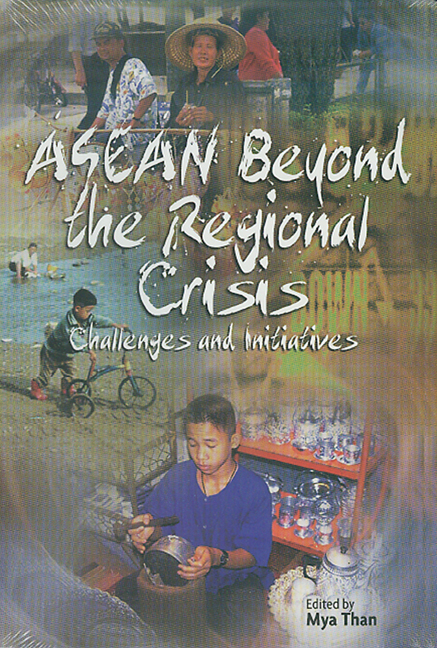Book contents
- Frontmatter
- Contents
- List of Tables
- List of Figures
- Glossary
- Contributors
- 1 ASEAN Beyond the Crisis: A Bird's-eye View
- 2 East Asia: Crisis and Recovery
- 3 Competitiveness and Sustainable Growth in ASEAN
- 4 ASEAN Free Trade Area: Progress and Challenges
- 5 ASEAN Investment Area: Progress and Challenges
- 6 Financial and Macroeconomic Co-operation in ASEAN: Issues and Policy Initiatives
- 7 Food Security in ASEAN
- 8 ASEAN Co-operation and the Environment
- 9 ASEAN and the International Trading System: Regional Trade Arrangement vs. the WTO
- 10 ASEAN and Its Inter-Regional Economic Links
- Appendix I ASEAN's Relevance: Has It Become Questionable?
- Appendix II Is ASEAN Still Relevant? Some Thoughts from a European Perspective
- Index
2 - East Asia: Crisis and Recovery
Published online by Cambridge University Press: 03 November 2017
- Frontmatter
- Contents
- List of Tables
- List of Figures
- Glossary
- Contributors
- 1 ASEAN Beyond the Crisis: A Bird's-eye View
- 2 East Asia: Crisis and Recovery
- 3 Competitiveness and Sustainable Growth in ASEAN
- 4 ASEAN Free Trade Area: Progress and Challenges
- 5 ASEAN Investment Area: Progress and Challenges
- 6 Financial and Macroeconomic Co-operation in ASEAN: Issues and Policy Initiatives
- 7 Food Security in ASEAN
- 8 ASEAN Co-operation and the Environment
- 9 ASEAN and the International Trading System: Regional Trade Arrangement vs. the WTO
- 10 ASEAN and Its Inter-Regional Economic Links
- Appendix I ASEAN's Relevance: Has It Become Questionable?
- Appendix II Is ASEAN Still Relevant? Some Thoughts from a European Perspective
- Index
Summary
The period 1997–98 was a very difficult time for Pacific Asia. Indonesia, Malaysia, South Korea, and Thailand experienced their worst economic performance in the last three decades, with their output in 1998 declining from 6 to 14 per cent. The resulting economic hardship sparked off political changes and social turmoil in these countries. The governments in Indonesia, South Korea, and Thailand were replaced, and a bitter power struggle broke out in once politically quiescent Malaysia. These were the very countries that the World Bank identified to be the “miracle economies” — the models of economic development for the rest of the developing world to emulate. This turn in events has caused many observers to revisit their development paradigms, and to ask whether the Pacific Asian economies were not “mirage economies” like those of the Soviet bloc. Is crony capitalism fatally flawed like central planning?
The claim that the Pacific Asian economies had imperfect economic institutions (for example, inadequate banking supervision and collusive relations between big businesses and government officials) is surely correct, but to go on to claim that these flawed economic institutions (“soft rot”) had reached breaking points simultaneously and thereby ignited the region-wide economic crisis is also surely incorrect. The second claim would be like focusing exclusively on deforestation in Central America when discussing the damage wrought by Hurricane Mitch, while ignoring the damage from the hurricane itself. Yes, policy failures matter, but they are only part of the story in Asia's financial storm. As much attention should be paid to the financial “hurricane” itself, specifically, the tendency for international financial markets to over-react both to positive and negative news. It was financial panic among international investors that brought Pacific Asia to its knees in 1998. Fortunately, the underlying fundamental strengths of the region are bringing about an economic recovery faster than has been widely predicted.
In general terms, we can say that there was little particularly “Asian” about the Asian financial crisis. Even though official Washington, led by the International Monetary Fund (IMF), proclaimed the crisis to be one of Asian capitalism, the more generic character of the crisis became all too clear during 1998, as the crisis spread to Russia, South Africa, and Latin America.
- Type
- Chapter
- Information
- ASEAN Beyond the Regional CrisisChallenges and Initiatives, pp. 11 - 28Publisher: ISEAS–Yusof Ishak InstitutePrint publication year: 2001

